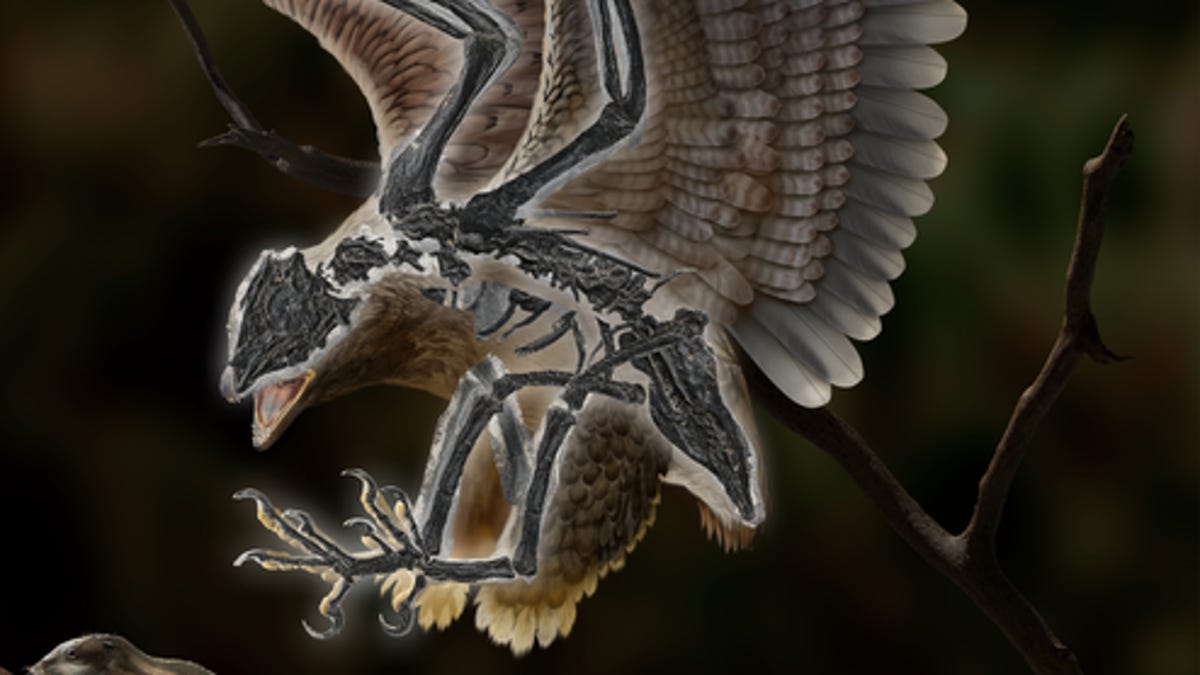Fossilized Species Had the Body of a Bird and Skull of a Dinosaur
This creature could help resolve the mystery of the T. rex turning into a chicken.

An artist's illustration of what Cratonavis zhui might've looked like long ago.
After analyzing a bizarre fossil specimen, believed to be about 120 million years old, scientists realized the remnants once belonged to an equally peculiar animal, with the body of a bird... and the skull of a dinosaur.
Though quite spectacular in itself, what's especially striking about this conclusion (which was published Monday in the journal Nature Ecology & Evolution) is that it adds to a major discussion about something paleontologists have been scratching their heads over for decades.
Basically, modern day birds are widely accepted as descendants of massive, meat-eating dinosaurs, called theropods, that roamed Earth between 245 million and 65.5 million years ago. And yes, this category includes everyone's favorite tiny-armed dino, the Tyrannosaurus rex.
But the thing is, we still aren't totally sure how the shift happened. In fact, fossil excavators rarely even stumble on beings that connect the ancient, scaly leviathans with today's feathered flyers. They usually find only either dinosaurs or avians.
This is where the newly discovered dino-bird comes in.
A full scale image of the artist's impression of Cratonavis zhui.
Named Cratonavis zhui, this strange creature appears to lie between the reptilian, long-tailed Archaeopteryx and a present-day bird clade, Ornithothoraces, on its family tree.
Archaeopteryx had long been known as the only fossil connection between birds and dinosaurs, as it had the feathered wings of a bird but the angular, bony back end of a dinosaur. But over time, more and more birdlike reptiles of the past began to surface. In the '90s, scientists announced the Ornithothoraces classification to encompass all modern birds and their closest ancestors.
Returning to Cratonavis -- aha! a direct link.
Inside the life of Cratonavis
The fossil finders from the Chinese Academy of Sciences studied their chimerical muse by using high-resolution computed tomography, or CT, scans.
That enabled them to digitally manipulate the specimen's bones and reconstruct the original shape of the skull, and even deduce some of its dinosaur-related functions. They also analyzed Cratonavis' scapula, or shoulder blade, and metatarsal, a long bone in the foot that connects the ankle to the toes, to understand more about its birdlike body.
Fast-forward a few scenes and they confirmed that Cratonavis' skull is morphologically nearly identical to those of dinosaurs like Tyrannosaurus rex, rather than those of standard birds, according to a press release on the study.
T. rex.
"The primitive cranial features speak to the fact most Cretaceous birds such as Cratonavis could not move their upper bill independently with respect to the braincase and lower jaw, a functional innovation widely distributed among living birds that contributes to their enormous ecological diversity," Li Zhiheng, a lead author of the study, said in a statement.
The being's scapula, on the other hand, was functionally "vital" to avian flight, said Wang Min, lead and corresponding author of the study. That means it helped Cratonavis exhibit strong stability and flexibility while airborne.
"The elongate scapula could augment the mechanical advantage of muscle for humerus retraction/rotation," Min continued, "which compensates for the overall underdeveloped flight apparatus in this early bird, and these differences represent morphological experimentation in volant behavior early in bird diversification."
But while this seems to be a huge step forward in understanding, at last, how something as ginormous as the T. rex could transform into a mere chicken, there's far (far) more to learn about the dinosaur-to-bird timeline.

